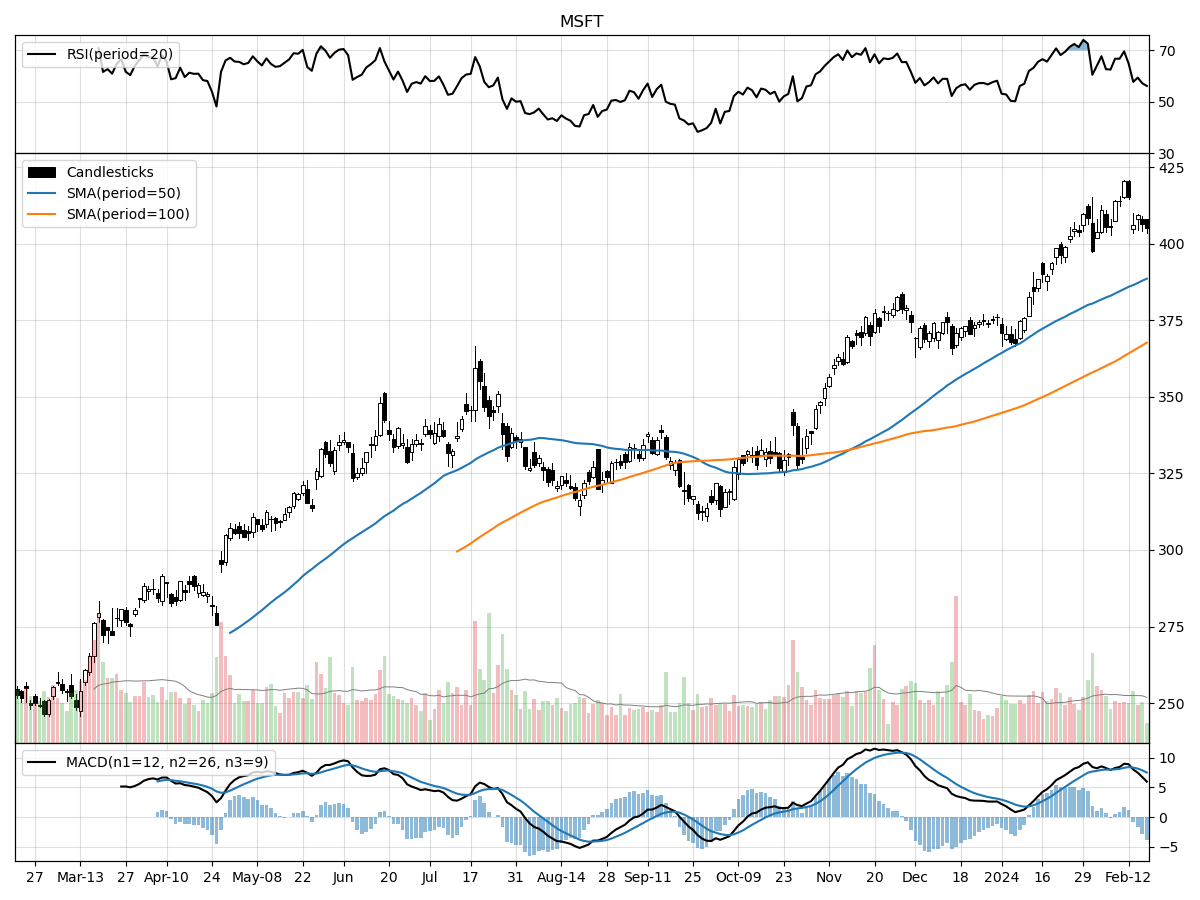AIIR Special Edition: Deep Dive into AI and Technology Leaders
Welcome to our first Special Edition, where we cover a set of companies of interest in a certain sector or area. Our first report will cover the AI technology leaders of Microsoft, Apple, Alphabet, Nvidia, and Meta. MSFT - AAPL - GOOG - NVDA - META

February 20 , 2024
Welcome to our first Special Edition, where we cover a set of companies of interest in a certain sector or area. Unsurprisingly, our first report will cover the AI technology leaders of Microsoft, Apple, Alphabet, Nvidia, and Meta. Unlike our typical weekly picks, these are not algorithmically/AI selected, but instead chosen by popular demand. Enjoy, and make sure to join (its free) if you want to read the whole thing!
MSFT - AAPL - GOOG - NVDA - META
Microsoft Corp. (MSFT)
Company Overview
Microsoft Corp is a technology giant with a diverse range of products and services. They operate in sectors like operating systems, productivity applications, server applications, video games, and hardware such as PCs, tablets, and gaming consoles. They also offer cloud-based solutions, consulting services, and online advertising. Microsoft has been focusing on AI, as seen in products like Microsoft Cloud and Microsoft Teams.
The company operates in several significant business sectors such as AI technology, gaming, cloud-based services, and first-party devices. They are planning to acquire Activision Blizzard, which would strengthen their position in the gaming industry. Microsoft is also investing in workplace transformation, AI, security solutions, and utilizing Windows to enhance their cloud business.
New areas of business that could drive revenue and profit growth include their AI-powered platforms, gaming industry investments, and sustainability initiatives. Their acquisition of Activision Blizzard and their AI Skills Initiative are expected to provide significant growth. Microsoft's commitment to reducing their carbon footprint and becoming more sustainable could open up potential revenue streams via green energy and carbon offset initiatives.
Microsoft also provides various productivity and business process products, including Office Consumer and Office Commercial, and LinkedIn. Their Intelligent Cloud services, including Azure and Nuance, offer both public and private server products and cloud services. Potential revenue drivers could be the shift from on-premises solutions to Office 365 and Dynamics 365, expanded product offerings, subscriptions for LinkedIn's monetized solutions, and growing demand for Azure's AI infrastructure and services.
In the AI sector, Microsoft faces competition from Amazon and Google. In server and systems management, they compete with Hewlett-Packard, IBM, and Oracle. In personal computing, they face competition in areas of database, business intelligence, software development, and enterprise services. However, Microsoft's advantage lies in its ability to provide integrated and comprehensive solutions across various business needs. Future revenue and profit growth could be driven by their investment in gaming studios, patent licensing, exclusive game content, and growth in devices.
By the Numbers
Quarterly 10-Q Report for Q2 Fiscal Year 2024:
- Microsoft Cloud Revenue: $33.7 billion (24% increase)
- Azure Growth: 30%
- Devices Revenue: Declined by 9%
- Activision Blizzard Acquisition: Completed for $75.4 billion
- Total Revenue: Increased by $9.3 billion (18% increase)
- Non-GAAP Gross Margin: Increased by $7.1 billion (20% increase)
- Operating Income: Increased by $6.6 billion (33% increase)
- Costs of Revenue: Increased by $2.1 billion (12% increase)
- More Personal Computing Revenue: Increased by $2.7 billion (19% increase)
- Windows OEM Revenue: Grew by 11%
- Xbox Content and Services Revenue: Increased by 61%
- Productivity and Business Processes Revenue: Increased by $4.4 billion
- Office 365 Commercial Growth: 18%
- Intelligent Cloud Revenue: Increased by $8.3 billion (20% increase)
- Research and Development Expenses: Slight increase
- Sales and Marketing Expenses: Increased by $567 million (10% increase)
- General and Administrative Expenses: Decreased by $360 million (15% decrease)
- Other Income (Expense), Net: Interest and dividends income increased
- Effective Tax Rate: 18% (down from 19% previous year)
- IRS Audit: For tax years 2014 to 2017, contesting significant proposed tax adjustment
These figures provide a snapshot of Microsoft's financial health and performance, indicating areas of growth such as cloud services and productivity tools, as well as challenges in the personal computing segment and the impact of significant acquisitions.
Stock Performance and Technical Analysis

As a stock analyst, it's important to consider a variety of technical indicators to assess the potential performance of a stock. The current stock price of $405.15 shows that the stock is trading near its 52-week high, which suggests a strong uptrend, but it also indicates that the stock might have limited upside potential in the short term if it's close to reaching a resistance level. The fact that the stock is 64% above its 52-week low demonstrates a significant appreciation over the past year, reflecting positive investor sentiment and potential momentum, but also raises questions about how much further it can go without a correction.
The trading volume provides insights into the stock's liquidity and investor interest. The recent daily volume slightly below the longer-term average volume could indicate a decrease in trader interest or consolidation, but the deviation is not significant enough to suggest a major shift in market sentiment. Consistent or increasing volume accompanying a price increase is typically a bullish sign, but the recent volume trend does not provide a clear signal in this case.
Money flow indicators are crucial to understanding the buying and selling pressure behind the price movements. The moderate buying pressure implied by some money flow indicators contrasts with indications of distribution from others, suggesting a divergence in viewpoints among market participants. This could signal a potential shift in momentum or highlight uncertainty in the market's direction for the stock.
The Moving Average Convergence Divergence (MACD) being bullish with a value of 7.499 indicates that the short-term momentum is stronger than the long-term momentum, confirming the recent positive trend. The bullish MACD is typically a sign that the stock could continue to climb in the short term, assuming other factors remain favorable.
In conclusion, the stock exhibits signs of a strong uptrend with its price near the 52-week high and a bullish MACD. However, the mixed signals from volume and money flow indicators, along with the stock's significant gain from its 52-week low, suggest a careful approach. It would be prudent to watch for any signs of a trend reversal or consolidation before making a decision to invest. Further analysis, including a look at fundamental factors, market conditions, and potential catalysts, would be necessary to make a well-informed investment decision.

The ‘Bull’ Perspective
Microsoft Corp - A Strategic Investment in a Digital Future
Upfront Summary:
- Impressive Cloud Growth: Microsoft's cloud revenue soared by 24% to $33.7 billion, with Azure's growth at 30%, reflecting the company's strong foothold in the expanding cloud market.
- Strategic Acquisitions: The successful acquisition of Activision Blizzard has significantly bolstered Microsoft's gaming segment, contributing to a 61% increase in Xbox content and services revenue.
- Financial Resilience: Microsoft's overall revenue grew by 18% to $9.3 billion for the quarter, showcasing robust financial health and an ability to generate substantial growth across its diverse portfolio.
- Adaptability to Inflation and Economic Trends: Despite the recent inflation data and potential interest rate hikes, Microsoft's diversified business model and innovation pipeline position it well to navigate economic fluctuations.
- Mitigating Identified Risks: Microsoft is proactively addressing its identified risks, from cybersecurity threats to supply chain disruptions, ensuring long-term stability and growth prospects for investors.
Elaboration on Key Points:
- Microsoft's cloud segment is experiencing a meteoric rise, with its Microsoft Cloud revenue surging by 24% to reach a staggering $33.7 billion. This growth trajectory is anchored by Azure, Microsoft's flagship cloud service, which itself saw a 30% increase. These numbers are not mere outliers but part of a consistent upward trend in the cloud sector, which is expected to continue as digital transformation becomes a priority for businesses worldwide. With a compound annual growth rate (CAGR) of 22% projected for the global cloud market through 2025, Microsoft's early and ongoing investment in cloud infrastructure and services positions it as a leader poised to capture a significant market share.
- The acquisition of Activision Blizzard stands as a testament to Microsoft's strategic foresight, with the deal already paying dividends through a 61% increase in Xbox content and services revenue. The $75.4 billion investment has not only expanded Microsoft's gaming library but also its potential in the burgeoning eSports and game streaming spaces. This move diversifies Microsoft's revenue streams and taps into the growing $159.3 billion global gaming market, which shows a projected CAGR of 9.17% from 2020 to 2025.
- Microsoft's financials tell a story of resilience and growth, with an 18% increase in revenue, amounting to $9.3 billion for the quarter. The company's non-GAAP gross margin and operating income have also seen significant upticks, excluding one-time charges such as restructuring costs. These strong financial indicators are reflective of Microsoft's ability to not only generate revenue across its various segments but also to manage costs effectively, ensuring a healthy bottom line.
- The recent inflation data and the potential for interest rate hikes have caused concern among investors. However, Microsoft's diversified business model, which spans cloud computing, productivity software, gaming, and more, provides a buffer against economic headwinds. The company's innovation pipeline, including advancements in AI and quantum computing, positions it well to adapt and thrive even in a challenging economic landscape. Moreover, the moderation in inflation rates predicted over the next year could ease cost pressures and support consumer spending, benefiting Microsoft's consumer-facing products and services.
- Microsoft is not immune to risks, but it is taking proactive measures to mitigate them. The company invests heavily in cybersecurity to protect against threats and data breaches, which is crucial as it expands its cloud services. On the supply chain front, Microsoft is working to diversify its supplier base and manage inventory effectively to mitigate disruptions. The company's legal team is also adept at navigating regulatory landscapes to minimize the impact of antitrust scrutiny and data privacy laws. By addressing these risks head-on, Microsoft is working to secure its position and reassure investors of its commitment to long-term growth and stability.
Conclusion:
Microsoft Corporation is a compelling investment option, demonstrating strong performance and strategic growth initiatives. Its burgeoning cloud business, wise acquisition moves, solid financials, adaptability to economic conditions, and proactive risk management strategies collectively underscore the company's potential for sustained growth. While no investment is without risk, Microsoft's track record and forward-looking approach present a robust case for investors seeking a resilient and dynamic addition to their portfolio.

The ‘Bear’ Perspective
Bearish Outlook on Microsoft Corp: A Prudent Approach in an Uncertain Market
Summary:
- Market Saturation and Competitive Pressures: Microsoft faces intense competition in a saturated market, which could limit growth opportunities and put pressure on profit margins.
- High Valuation and Growth Sustainability: Microsoft's current valuation is steep, raising concerns about the sustainability of its growth trajectory amidst evolving market conditions.
- Regulatory and Legal Challenges: Ongoing legal and regulatory scrutiny could result in significant fines and operational limitations for Microsoft.
- Cybersecurity and Data Privacy Concerns: Increasing cybersecurity threats and data privacy issues pose significant risks to Microsoft's reputation and financial stability.
- Economic Headwinds and Inflation Impact: The broader economic environment, including inflation and interest rate hikes, could adversely affect Microsoft's business performance.
Elaboration:
- Market Saturation and Competitive Pressures:
Microsoft operates in a highly competitive and saturated technology market. With a market capitalization surpassing $2 trillion, the company's growth prospects in core areas such as operating systems, productivity software, and cloud computing are increasingly challenged by competitors like Amazon Web Services, Google, and emerging tech startups. For instance, despite Azure's 30% growth, it still trails behind Amazon's AWS in the cloud sector. Furthermore, the 9% decline in Devices revenue suggests market fatigue and the need for continuous innovation to maintain consumer interest. If Microsoft cannot differentiate its offerings or penetrate new markets effectively, its long-term profitability could be at risk. - High Valuation and Growth Sustainability:
Microsoft's stock trades at a premium, reflecting high expectations for future growth. However, with a Price/Earnings ratio significantly above the market average, investors may begin to question the sustainability of its growth, especially in the face of a 24% surge in Microsoft Cloud revenue that may be difficult to maintain as the market matures. The acquisition of Activision Blizzard, while potentially lucrative, also adds $75.4 billion in expenses that must be justified through successful integration and revenue generation. Any shortfall in meeting these high growth expectations could lead to a reevaluation of the stock's worth and a potential sell-off. - Regulatory and Legal Challenges:
Microsoft's global operations expose it to diverse regulatory landscapes, including antitrust concerns and data protection laws. For example, the company is currently under IRS audit for tax years 2014 to 2017, contesting a significant proposed tax adjustment related to intercompany transfer pricing. Such disputes can result in hefty fines and damage investor confidence. Additionally, antitrust laws in major markets like the U.S. and EU may limit Microsoft's strategic moves, such as the integration of newly acquired Activision Blizzard, potentially hampering its ability to compete effectively. - Cybersecurity and Data Privacy Concerns:
As a leading technology provider, Microsoft is a prime target for cybersecurity threats. Data breaches and privacy violations can lead to substantial financial losses and erode customer trust. For example, operational risks related to cloud services and AI development could translate into increased liability and higher costs for security enhancements. In today's data-driven economy, a major breach could have far-reaching consequences, including regulatory fines and a decline in user engagement, which would directly impact Microsoft's bottom line. - Economic Headwinds and Inflation Impact:
The recent inflation data, with the headline CPI at 3.1% and core CPI at 3.9%, suggests that inflationary pressures remain persistent. For a giant like Microsoft, this could translate into higher operational costs, particularly in hardware production and cloud infrastructure deployment. Coupled with the Federal Reserve's interest rate hikes, these economic headwinds can lead to reduced consumer spending and corporate investment, potentially slowing down Microsoft's revenue growth. While the company has a robust balance sheet, the broader economic conditions could still dampen its financial performance and stock price momentum.
In conclusion, while Microsoft has demonstrated impressive growth and resilience, investors should approach its stock with caution. The combination of market saturation, high valuation, regulatory hurdles, cybersecurity risks, and economic challenges presents a complex landscape that could affect the company's future performance and, consequently, its stock value. Prudent investors should weigh these risks carefully against the potential rewards before making investment decisions.
Apple Inc. (AAPL)
Company Overview
Apple Inc. is a leading technology company that designs, manufactures, and markets a wide range of personal technology products, including the iPhone, Mac, iPad, and various wearables and accessories. It also provides a suite of services, such as advertising, AppleCare, cloud services, digital content platforms, and payment services like Apple Card and Apple Pay. The company markets its products to consumers, businesses, education, enterprise, and government markets through various channels including direct retail and online stores, third-party cellular network carriers, wholesalers, retailers, and resellers.
Apple operates in a highly competitive landscape, where factors such as price, product and service features, quality and reliability, product innovation, marketing and distribution capability, and corporate reputation play significant roles. The company's business model relies on strategic agreements with suppliers for key components, significant research and development initiatives, and a broad collection of intellectual property rights. As of September 2022, Apple employed approximately 164,000 full-time employees, with a strong focus on inclusive and diverse workforce practices and competitive compensation. The company's financial reports and other investor information can be accessed on their official website.
